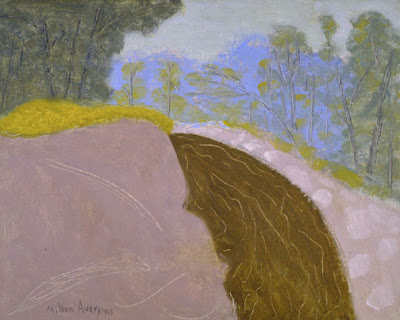And in no particular order…I’m starting with Milton Avery, mainly because his colourful semi-abstracted landscapes are in the same area that I’m currently working in, albeit in a very different style.
Milton Avery (1893 – 1965) was born at Sand Bank, New York. After studying for a while at the Connecticut League of Art Students in Hartford under Charles Noel Flagg and at the Art Society School there under Albertus Jones, Avery worked in manufacturing and with an insurance company until 1924. He moved to New York in 1925 and married the artist Sally Michel, an illustrator, a year later.
He had his first one-man show as early as 1928 at the Opportunity Gallery in New York. The decades that followed saw him show work at numerous exhibitions mounted by New York galleries and American museums. Milton Avery's preoccupation with French Fauvism and German Expressionism led him to develop a simplified formal idiom distinguished by clarity of line and an expressive palette. Whereas Avery's early figurative drawings and paintings from the 1930s attest to affinities primarily with the work of Ernst Ludwig Kirchner, by the 1940s he was discernibly close to Henri Matisse.
As the American upholder of Matisse's colouristic doctrine, Milton Avery developed the French artist's decorative colour surfaces into subtly toned colour zones, thus breaking the ground for the Colour Field painting of Mark Rothko (see blog post July 2010) and Adolph Gottlieb (blog post to come), both of whom were friends of his. Even though his style was close to abstraction, Milton Avery nonetheless clung to representation throughout his entire career. Classical motifs and subject matter in portraits, still lifes and coastal landscapes were his main thematic areas and genres.
Prolific as a painter, graphic artist and ceramist, Milton Avery received numerous awards from American art institutions before he died in 1965 although he only really became famous posthumously. He is now acclaimed as one of the most influential American C20th artists.
1936 Vermont Hills
1940 Gaspe - Pink Sky
1944 Autumn
1944 Bridge to the Sea
1945 Three Cows on Hillside
1952 Breaking Sea
1952 Shapes of Spring
1953 Advancing Sea
1953 Excursion on the Thames
1954 Green Sea
1954 White Wave
1955 Spring Brook
1957 White Moon
1958 Green Sea
1958 Offshore Island
1958 Onrushing Wave
1958 Sea Grasses and Blue Sea
1959 Black Sea
1959 Boathouse by the Sea
1961 Blue Bay and Dunes






















































